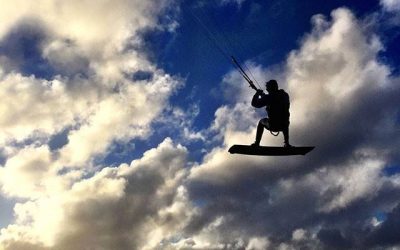
By: Bill Swezey
One of the most impressive things to witness on a windy day is a kiteboarder soaring high above water level being held up by just few thin lines and a colorful kite. The physics of the jump may seem nearly impossible to a non-kiter, which makes the stunt even more mesmerizing. Many people think waves are needed to launch off of to get the hang time but huge airs can be achieved off a perfectly flat body of water as well. Experienced kiteboarders know the real keys to big jumps are speed, kite position, and timing.
In order to perform a successful jump, a kiteboarder must already be capable of riding well. Kite control and the ability to hold a good edge are imperative to a successful jump. The whole jump starts with speed. The faster a rider is moving the more potential there is for a huge air. This brings us to our next point, edging. The faster a rider is moving the more difficult it becomes to hold a solid edge against the kite. Edging is like having “grip” on the water with a board. If a rider looses his edge the kite will pull him downwind rather than perpendicular or slightly upwind.
As the kiteboarder is riding with speed and holding a good edge there is tension built up in the lines. Once ready to launch the rider quickly steers the kite overhead and a bit past 12 o’clock in the other direction. This is where timing comes in. The kiteboarder has to hold his edge against the tension of the lines pulling him upwards until the very last moment to receive maximum height. Once released from the water the force of the kite pulling up and a bit back against the forward speed of the rider yanks him high and allows him to almost “swing” underneath the kite. In these few moments the rider has a chance to do some creative tricks before preparing to land.
Landing is the most important part because without a smooth landing those creative tricks in the air are null. The rider starts to descend from maximum height and begins to time his contact with the water. A moment before contact is made the kiteboarder steers his kite down to pull him forward so he can ride away smoothly with forward speed, usually in the same direction that he started his jump.
Speed, a smooth release from the water, and timing the jump off the lip of a wave, are all things that can help a rider reach maximum height. However there is no substitute for practice and getting the “feel” down. Keep these physics in mind the next time you see an ocean of kiters or the next time you are out riding yourself and want to add big airs to your quiver of tricks.





